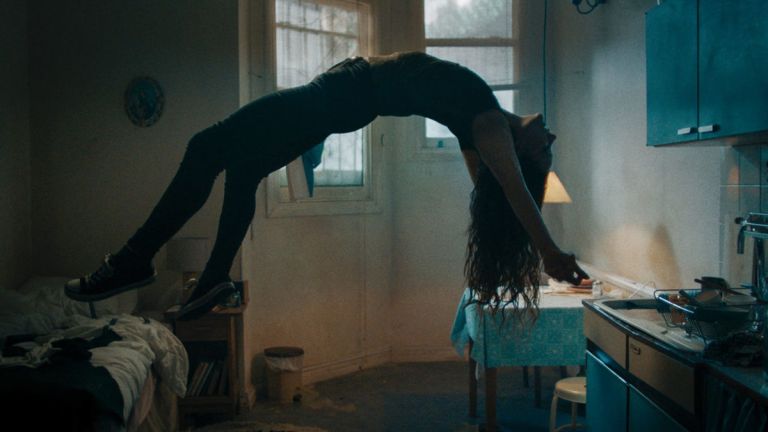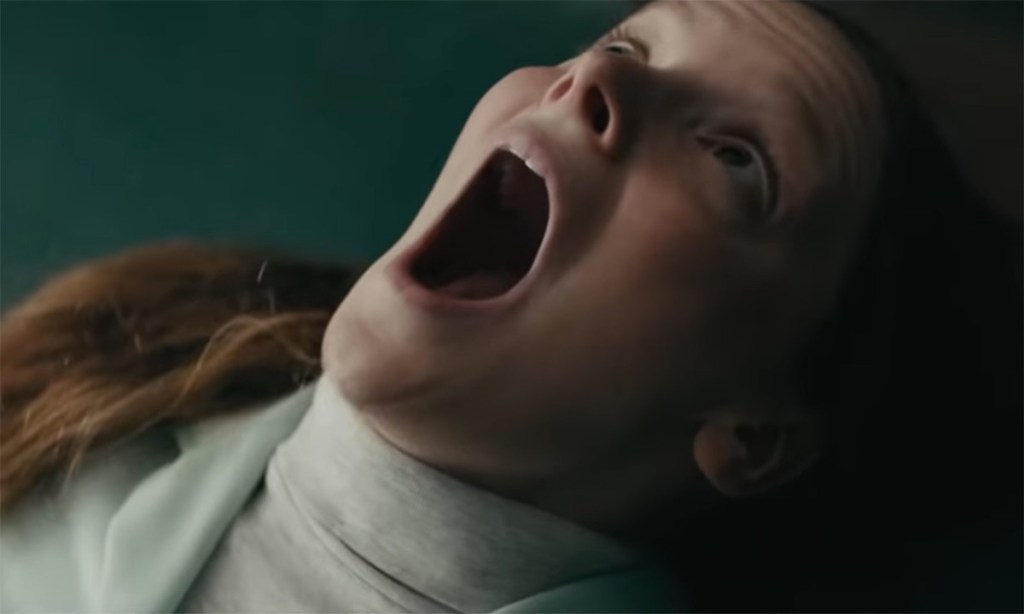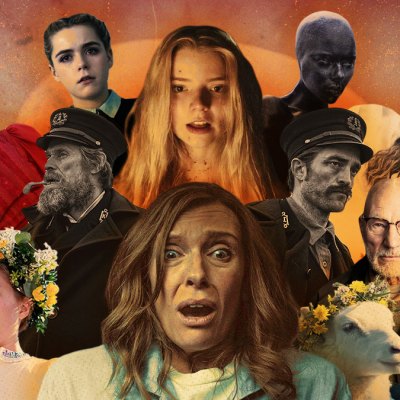Saint Maud and the True Horror of Broken Minds and Bodies
Director Rose Glass on how her horror debut Saint Maud explores mental, corporeal and spiritual breakdowns

Spoilers for SAINT MAUD to follow
If there hadn’t been a pandemic one of the horror movies everyone would be talking about this year would be Saint Maud. We’d be talking about it in the same breath as Hereditary, The Witch, The Babadook and Raw, but we’d know that it isn’t really like any of them. We might mention Repulsion, The Exorcist, Rosemary’s Baby, but we’d know what we’d seen is new and exciting.
Release in UK cinemas on October 9 after getting pushed back and pulled forward several times, Saint Maud can finally find its way to audiences who feel comfortable going to the pictures – with a digital release to follow.
This is director Rose Glass’ debut film, an incredibly confident first feature which sees Morfydd Clark’s pious palliative care nurse believe she is on a mission from god to save the soul of her dying patient, former dancer Amanda (Jennifer Ehle). Set in a squalid seaside town this is a film that pits faded glamour and rough reality against the beatific visions of the troubled Maud – it’s at once beautiful and hellish.
We caught up with Glass to talk about minds and bodies, a Welsh God and the horrific true story behind Maud’s past.
Would you describe Saint Maud as horror?
I don’t know, I’m having less and less of an opinion on the whole genre thing now, to be honest. I guess it’s somewhat subjective. Why do people put such rigid labels on things? It’s a film. I’ve been told people find it scary. It’s not like some of the bigger, more mainstream, jump scares every minute ones. And neither is better or worse, I guess they’re just slightly different styles. But yeah, it’s more horror than it is not.
What were the origins of Maud, where did the concept first come from?
I started coming up with the early version of the idea just as I was finishing film school in 2014. It was just a premise that I thought would be fun. It was going to be a two-hander of a young woman who hears the voice of God in her head and falls in love with him. It was going to be some sort of twisted romance between her and God, but it started to go quite gimmicky quite quickly. That was what set me off down that path. But it was always about a woman who had this voice in her head.
At first I didn’t question at all how literal that was or not, or whether or not that meant God or mental illness. So then I started wondering a bit more about that and started realizing there are two different ways you could be doing this same scenario, depending on whether you have faith or not, which I thought was quite interesting and deliberately a bit provocative and fun. It’s an amalgamation of lots of stuff that I’m interested in, mental illness and religion, and brains and bodies going wrong and all that sort of stuff.
It struck me as about a conflict between mind and body and soul…
The ridiculousness of being a human and at once the world in our brains being able to encompass such huge concepts and be so far reaching and epic, and apocalyptic within our minds, but then the mundane reality of life. Not to mention the fact that all of us are walking around in weird fleshy body things that can go wrong, and the brain’s just an organ. And what the fuck is consciousness? It’s all mind-boggling, so for me I guess, storytelling and films and art is often just trying to find weird varied ways to make sense of all that.
The settings and your locations really help with that. The comparison between these lofty ethereal visions and these squalid moments of hell in the flat. Can you tell me a bit about the locations and what you were looking for when you were hunting down those places?
I think that, what you said, that was it. I wanted to find ways for the visual language and setting of the film to reflect what’s going on. So yeah, when she’s on her sacred mission and trying to help Amanda in her house, that’s high above the town looking down on everybody and that’s kind of how she is. And then her crappy little bedsit is meant to have the feel of a hermitage or some kind of, I don’t know, not monastic, but something very basic.
How did you manage to achieve that terribly oppressive, hellish look and feel to the film?
I always wanted the whole film to be incredibly subjective, and for the audience to always be very much aligned with Maud’s experience. And for me, the whole challenge of the film was to see if I could get the audience to connect with and understand somebody who goes on to do such seemingly inexplicable, awful things. There’s a version of the story that could have been told and shot like a very bleak, social realism drama about an unemployed nurse who’s struggling with mental health issues. And while that is definitely in the story, I wanted to tell it from her perspective. Because obviously, she doesn’t see herself as this unfortunate downtrodden victim. She sees herself as somebody incredibly important. She’s in direct communication with God. This is all massive high stakes stuff. Otherwise you don’t get what’s driving her.

Her day-to-day life, job, is quite mundane and she’s looking for the thing that makes her feel important and seen and special. So her relationship with God and the whole journey that she thinks she’s going on with Amanda, it had to feel as important, sexual and exciting as the character finds it. Then the whole drama comes from the conflict between what she thinks is going on, and what’s actually going on.
The look of it had to be super sensual and stylized. I work with Ben Fordsman who’s my DOP, it’s his first film as well. He’s fantastic. We talked a lot about making the visual style reflect her unraveling mental states. At the beginning things were a lot more controlled, in terms of camera and lighting and camera movement, and then gradually as she unravels throughout the film, the style of the whole film gets more and more extreme.
The fact that Maud is very strong, believes she’s on a mission from God and doesn’t feel sorry for herself makes this a very different film.
She’s a very contradictory character, which to me just seems more realistic. None of us are just one thing. I wasn’t so aware of this until I actually watched, with editing the film and shooting, and Morfydd said the same thing when she watched it for the first time. Because we both are physically small women, it’s not something you’re conscious of but in terms of how you come across in the way she looks there’s already like a natural frailty or vulnerability which makes you want to go, “Oh.” and help her. But then actually everything else beyond that, beyond how she looks, in her performance, and how she interacts with people, it’s quite spiky and tough, quite arrogant. I like these neurotic characters, with weird levels of arrogance and self-loathing. Neurotics with stomach aches, and arrogance and self loathing. Encompassing lots of things, contradictory, multifaceted, she’s chameleon and very funny.
To me this feels like a really female film. Was that something that you were really conscious of and deliberately wanted to do? Or was that just because you happen to be a female?
Yeah, the latter. I don’t know. I feel like with the horror vibe, sometimes feel like I’m not saying what I should. No, I’ve never thought of myself as a female filmmaker, and what is the thing I have to say as a woman. I just come at things as an individual. I think it’ll be good when audiences can think more like that as well. But at the same time, I don’t want to be ungrateful. I’m really aware of the fact that I’m really fortunate to be coming up at this time where, because of the hard work that a lot of other people have done before me, audiences and the industry are more open than they have been before to stories about women. So I’m certainly benefiting from that. I wish I didn’t have that little bit of voice in my head that’s like, “Oh, so are you just ticking a box…”
There are certainly themes of how these two women connect to their bodies.
I’m very interested in weird relationships that we all have with our bodies, and obviously, I’m coming at it from a female perspective, because I am a woman. [I’m interested in] the contrast between his alternate epic inner world and how limiting bodies are sometimes.
When Maud hears the voice of God it’s actually Morfydd’s own voice we are hearing, I gather?
Yes. And it wasn’t in the original script. Going in to shoot the film, that scene didn’t exist. I think I’d been a bit too ruthless with trying to cut the script down so it would be short and contained. There are things that you think come across because you’ve written it and you’re familiar with it, and then you look in the edit and you’re like, “Oh shit, we need this scene.” It felt like we needed an unambiguous scene where God reveals himself to her and talks. So then it was like, “What does God look and sound like?” So I’d already had this beetle that we’d done some stuff with, so I was like, “Great, get the beetle in.” And then it’s like, “How does the beetle sound?”
I’d been listening to Morfydd talking on the phone to her sister in Welsh throughout the shoot, and it’s just this lovely sounding language, which I think is unfamiliar to most people. I probably wouldn’t have recognized it. Everyone’s kind of, “Is it Latin? Is it Aramaic?” Then you go, “It’s Welsh.” And then you’re like, “It’s Morfydd’s voice pitched down and everyone goes, “Ooh.”
Where did Maud’s backstory originate?
It’s a story I actually nicked from a woman that I met at a friend’s birthday party who was a nurse. I was talking to her a bit about the film before we’d shot it. I was running it by her, the idea of this traumatized nurse, who’s left the public sector and gone to work as a private carer. And there’s this kind of unresolved, untreated trauma that she’s gone through. She’s basically losing her mind and no one’s realized. “Does that sound plausible?” And she was like, “Yeah, totally.” I’d already read a lot of stories about nurses and doctors and public health workers grappling with mental health issues, because it’s a great, insane field to work in.
This woman told me this thing that happened to her, where she’d been working on a intensive care unit for people with lung problems. There was a guy, an old man, who was recovering from some major chest surgery and he was either in a coma or asleep, I’m not sure. He’d been sort of, sliced and stapled here [gestures down the centre of her chest] and this nurse was doing the night shift and he crashed, went into some kind of cardiac arrest. She had to start doing CPR and he was so frail, and he’d just had this surgery, which was sort of open. And yeah, her hands just kind of, went inside and he died…
Wow.
Awful, yeah. Fortunately, in this woman’s case, she got a ton of therapy and worked through it, but had PTSD. So to be honest, the real thing that happened to her, I think, is more horrifying than what actually did in the film, because we tried to do that effect, but it didn’t work. In our film you see the chest, there was a cavity inside that fake chest. It was meant to be that Morfydd’s hands went all the way inside, but it didn’t quite work. Then actually, the first take that we did where it didn’t break it just crushed, that actually made the whole crew wince. So actually we just ended up using that. Putting in a little bit of fake blood, so it’s less gory than the real thing that happened. But I think it’s more effective in the film anyway. So yes, that lady’s awful trauma, I’m making a film out of it. I’m not sure about the moral implications of that but… Anyway, that’s what I did.
When you were at film school till 2015, and you’ve made quite a lot of shorts before, I wondered if you see common themes or preoccupations within your work?
You start to work out what your things are. For me, they definitely seem to be bodies and brains going wrong, always loved bodies and brains. Insects are getting in there as well. At least two of the next projects are definitely quite body focused.
What can you tell us about those?
Only that there’s one which is set in America and that’s going to be a rather horrible romance, or lovely romance, depending how you look at it, I guess. And the other one is the sort of, slightly more body horror one, which I was writing mostly during lockdown, but I can’t say any more.
In terms of the title, is there a real Saint Maud?
There is. That’s not who she’s named after though. Initially, the film was just called, “Maud”. Then “Saint Maud” only came about once I worked out that she isn’t actually Maud, she’s Katie, and Maud’s kind of an identity she’s created for herself. I think there was one, I want to say she was something like the patron saint of naughty school children, something like that.
Your film is finally coming out in cinemas and I know it’s been moved around a bit. So how does it feel that you’re finally getting your release?
Great. Very weird. Very nice. I keep forgetting that the main thing hasn’t happened yet, with coming up in festivals and all of that stuff. To me, it sort of feels like Maud’s kind of done, so I’m thinking about the next stuff now. I keep forgetting that it’s not actually been released yet. I’m curious to see what regular audiences think of it.
Saint Maud is out now in UK cinemas


